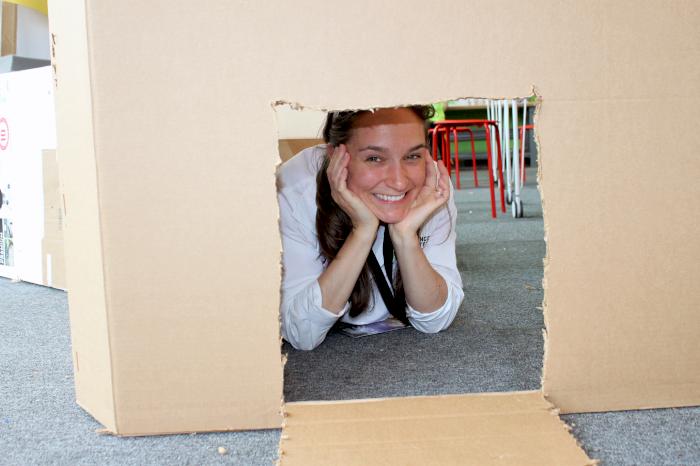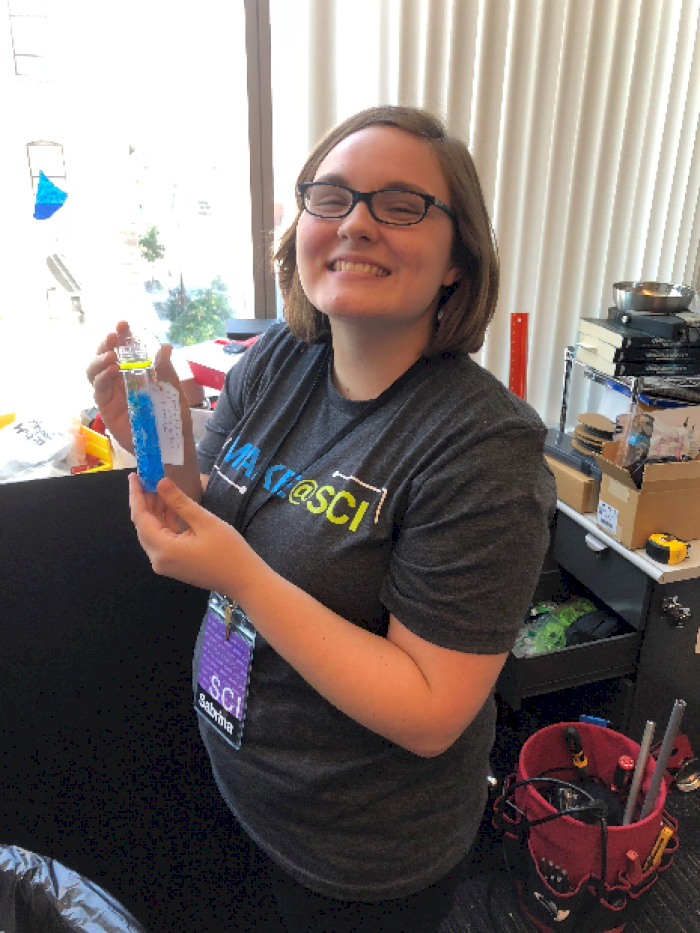Meet Our Maker: Ellie Willhoit
- Wednesday July 25 2018
- Make@SCI
Have you ever wondered who comes up with the projects for the Summer of Making? Meet Ellie! From Studio Time to Member Family Workshops, Ellie tells us about how she got started, what she loves about her job and what aspiring Makers can do to get started.
SCI: Can you tell us a little about your role is at the Science Center of Iowa?
Ellie: I do a little bit of a lot of things! I started four summers ago as a Resident Maker, and I’m now the Programs Coordinator. During the school year, I work on the Programs Team and create curriculum plans for the Member Family Workshops and other programming. During the summer, I switch gears and help run the Maker program.
SCI: What got you interested in making in the first place?
Ellie: I think we are all makers at heart. My husband and I always liked to tinker with things. We took some time off work and helped our friends build a letterpress studio, which was a lot of fun. When I eventually saw the job posting from SCI, I jumped on it!
SCI: What is your favorite project you’ve worked on at SCI?
Ellie: I have a blast doing the family night workshops. This last family night, we made rubber band helicopters, which was hilarious. You give people a template for what they’re going to make, and then you let them experiment. People got really creative, and about halfway through, it was raining propellers and rubber bands from the ceiling. It was amazing, and a lot of fun!
SCI: For people who don’t know, what are Member Family Workshops?
Ellie: Member Family Workshops happen the second Friday of every month. It’s a night where we have $5 admission, and we stay open until 8. We have free member workshops that people can register for – you need to be a member to get into it, but it is a free perk of being a member.
SCI: What do you think is your favorite part of your job?
Ellie: Being out on the floor and hanging out with people! I really like seeing kids get creative with the projects we present them with. Sometimes I get surprised with the stuff they come up with.
Studio Time is also really fun. We’ve had some great experimenters, and it’s exciting when we get kids that are comfortable working through the engineering-design cycle, and being okay with a project that doesn’t work perfectly, then tweaking it until it works the way it’s supposed to.
SCI: That’s what makes you a good maker, right?
Ellie: Right! Making happens when you see something that doesn’t work, and you fix it or improve it.
SCI: Can you think of any really creative things you’ve seen in the Maker Studio?
Ellie: There was a kid who came by Studio Time after working at our tool benches. He made a Tyrannosaurus Rex out of wooden blocks, but he built a swinging mechanism into it so his head would move. Honestly, I don’t think I’ve ever seen anything like that come out of Tool Time before! It’s great how he just took some regular tools and some screws and wood, and created an object with moving parts. I was blown away!
SCI: Are there any projects that you haven’t been able to make work?
Ellie: This is something I have to think pretty hard about. We did a collaborative art project last year that ended up being really challenging, but it was mostly just from a printing perspective and trying to figure out how to get it mounted the way we wanted it to. It ended up working out okay, but it kinda made me want to pull my hair out towards the end. It was a photo mosaic, so we took picture of visitors throughout the summer, and then we uploaded them and had another photo composited on top of it. All the little pictures were tinted in the right way, so when you stepped further way, the mosaic looked like something else. It was time-consuming, but we did finish it in the end!
SCI: How do you come up with your projects?
Ellie: It depends on the project. A lot of times, we’ll get inspiration from things online, but we’ll tweak it so it works with our program. For example, a project for Studio Time will be more open-ended so a 3-year-old and a 53-year-old will both be able to experiment with it. If we’re doing something for the summer camps, we’ll make sure it ties into the theme of the camp and is age-appropriate for our campers. Overall, it’s a mixture of Google-ing, a lot of prototyping and tons of experimenting to make our projects work.
SCI: What do you recommend for people who want to start making?
Ellie: Just start making things! Figure out something you’re interested in, and just try making it and see how it works. If it doesn’t work great you can try experimenting and helping it work better and do it again!
The Summer of Making will be going on throughout the summer at the Science Center of Iowa. While you stop by to create, invent and explore, be sure to save the date on Monday, September 3 to come to our Maker Faire! The Des Moines Mini Maker Faire features dozens of exhibitors, tons of projects, games, food trucks and most importantly, fun! To learn more (or to sign up to be an exhibitor), visit http://desmoines.makerfaire.com/ , and be sure to check our social media channels for exciting news and updates!


